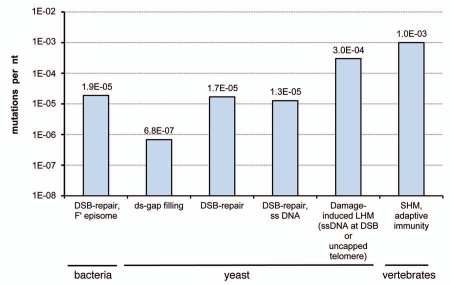Figure 1.
Mutation frequencies associated with various kinds of localized hypermutability. Mutation frequencies were derived from the following publications: DSB-repair, F′ episome-E. coli mutations selected in F′ codA,B genes with a mutation target size of 848 bp was used for calculations;84 Double-stranded (ds) gap repair—mutations in the yeast URA3 gene occurring during a double-stranded (ds) gap repiair,30 a minimal estimate of mutation target of 125 bp as determined by;85 DSB-repair—frequency of spontaneous mutations in the vicinity of a DsB repaired by homologous recombination.32 A site-specific DsB was induced next to the chromosomal CAN1 gene and repaired by homologous recombination with a truncated copy of CAN1 in the same chromosome. Unlike a double-strand gap in reference 30, DSB ends homologous to adjacent segments of DNA sequence were used for repair. this system did not allow distinction between hypermutability in transiently formed ssDNA (as in ref. 29), or hypermutability during repair of a ds-gap (as in ref. 30). DSB-repair in ssDNA—in this system the CAN1 reporter gene was placed in the vicinity of a DSB that was repaired by a short oligonucleotide, so the CAN1 sequence did not participate in recombination and the most likely hypermutable intermediate was transient ss DNA (ref. 29 and Fig. 2A). The probability of CAN1 mutations in both DSB-repair systems was calculated based on the frequency data corrected for the minimal estimate of mutation target (236 bp as determined by ref. 85). Damage-induced LHM (ssDNA at DSB or uncapped telomere). Average frequencies of mutations induced by Uv-C (45 J/m2) and MMS (30 min in 11.8 mM (0.1%) MMS) in yeast ssDNA around DsB or next to uncapped telomere were taken from references 29 and 45. SHM, adaptive immunity. Approximate frequency of mutations associated with somatic hypermutation in the Ig-genes was taken from references 34 and 35.

